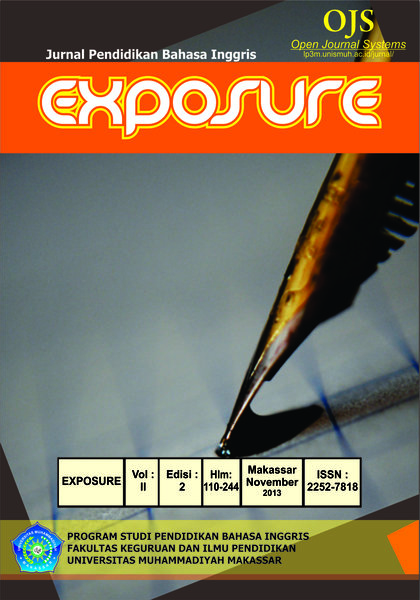IMPROVING THE STUDENTS’ READING COMPREHENSION THROUGH KNOW-WANT-LEARN STRATEGY
DOI:
https://doi.org/10.26618/exposure.v2i2.793Abstract
Improving The Students’ Reading Comprehension Through Know-Want-Learn Strategy at the first-grade students of SMA Negeri 18 Makassar. The objective of this research was intended to explain the improvement of the students’ interpretative and literal reading comprehension through Know-Want-Learn Strategy at the first-grade students of SMA Negeri 18 Makassar especially in class X 3. The strategy of this research was a Classroom Action Research (CAR) consisted of two cycles, one cycle consisted of four meetings. It means that there were eight meetings for two cycles. This classroom action research was done at the first-grade students of SMA Negeri 18 Makassar in Daya Regency for English subject. As the subject in this research was class X 3 in the 2012-2013 academic year with students’ number of about 32 students. Those consist of 22 women and 10 men. The instrument of this research was observation sheet and reading test or evaluation. The findings of the research were students achievement in reading comprehension was 54,07 in D-test, then Cycle I is 69,07 and it becomes 73,81 in Cycle II. The students' activeness in learning reading comprehension in the first meeting of Cycle I was 45,39% then it becomes 90,78% in the fourth meeting of Cycle II.
Keyword: Improving, reading, know, want, learn, strategy.
References
Armbruster, B. Lehr, F & Osborn, J. 2001. Put Reading First: The Research Building Block for Teaching Children to Read. Washington, Dc: The U.S.
Brewton. 1962. Teaching Reading in the Content Areas. mcRel, Colorado.
Bonwell, C. & Eison, J. (1991). Active learning: Creating excitement in the classroom. ERIC Digest. Available. Retrieved from http://www.ed.gov/databases/ERIC_Digests/ed340272.html. On July 29 2012.
Bos, C.S & Vaughun, S. 2002. Strategies for Teaching Students with Learning and Behavior Problem. Boston: Allyn and Bacon Retrieved from http://www.answers.com/or http://answers.yahoo.com.On 24th August 2012.
Buehl, D. 2001. Classroom Strategies for Interactive Learning. Second Edition: Network, Delaware, International Reading Association.
Carr, E. & Ogle, D. 1987. K-W-L Plus: A strategy for comprehension and summarization. Journal of Reading.
Gay. L, R. 1981. Education Research: Competencies for Analysis and Applicant. Columbus: A Bell and Howell Company, Charles, E. Merril Publishing Co.
Frederiksen, 1981. An Introduction to Language. New York: Havfix.
Karolina, Intan. 2006. Increasing the Students Reading Comprehension through Know Want Plus Method. Thesis: UNESA Surabaya.
Lamuhiddin, 1988. Correlation between Vocabulary Command and Reading Comprehension of the second year students of SMA Negeri 3 UP. Thesis: FPBS IKIP UP.
Maryam. 2007. Learning Cooperative Reading through the Narrative towards the Contextual Meaning (A Study of Comprehension View). Thesis: Unismuh Makassar.
Mattis, K. 2005. Reading Comprehension. New Jersey: Person education, inc.
Ogle, D.M. 1986. A teaching Model Develops Active Reading of Expository Text. Retrieved From http://www.indiana.edu/~1517/KWL. on 25th August 2012.
Omar, Salim. 2010. The Impact of Using KWL Strategy on Grade Ten Female Students' Reading Comprehension of Religious Concepts in Ma'an City. Thesis: University of Al Husein Bin Talal, Jordan.
Peregoy, S. & Boyle, O. (2001). Reading, writing & learning in ESL. New York: Addision Wesley Longman.
Priyono. 2010. Improving Students’ Reading Comprehension Through A Kwl Strategy.Thesis: UNS Surakarta.
Sampson, M. (2002, March). Confirming a k-w-l: Considering the source. Reading Teacher, 55(6), 528-532. Academic Search Complete database. Retrieved on July 15, 2012.
Tierney, R. & Readence, J. (2000). Reading strategies and practices. Boston: Allyn & Bacon
Downloads
Published
Issue
Section
License
Authors who publish with this journal agree to the following terms:
In order to assure the highest standards for published articles, a peer review policy is applied. In pursue of the compliance with academic standards, all parties involved in the publishing process (the authors, the editors and the editorial board and the reviewers) agree to meet the responsibilities stated below in accordance to the Journal publication ethics and malpractice statement.
Duties of Authors:
- The author(s) warrant that the submitted article is an original work, which has not been previously published, and that they have obtained an agreement from any co-author(s) prior to the manuscript’s submission;
- The author(s) should not submit articles describing essentially the same research to more than one journal;
- The authors(s) make certain that the manuscript meets the terms of the Manuscript Submission Guideline regarding appropriate academic citation and that no copyright infringement occurs;
- The authors(s) should inform the editors about any conflict of interests and report any errors they subsequently, discover in their manuscript.
Duties of Editors and the Editorial Board:
- The editors, together with the editorial board, are responsible for deciding upon the publication or rejection of the submitted manuscripts based only on their originality, significance, and relevance to the domains of the journal;
- The editors evaluate the manuscripts compliance with academic criteria, the domains of the journal and the guidelines;
- The editors must at all times respect the confidentiality of any information pertaining to the submitted manuscripts;
- The editors assign the review of each manuscript to two reviewers chosen according to their domains of expertise. The editors must take into account any conflict of interest reported by the authors and the reviewers.
- The editors must ensure that the comments and recommendations of the reviewers are sent to the author(s) in due time and that the manuscripts are returned to the editors, who take the final decision to publish them or not.
Authors are permitted and encouraged to post online a pre-publication manuscript (but not the Publisher’s final formatted PDF version of the Work) in institutional repositories or on their Websites prior to and during the submission process, as it can lead to productive exchanges, as well as earlier and greater citation of published work (see The Effect of Open Access). Any such posting made before acceptance and publication of the Work shall be updated upon publication to include a reference to the Publisher-assigned DOI (Digital Object Identifier) and a link to the online abstract for the final published Work in the Journal.

